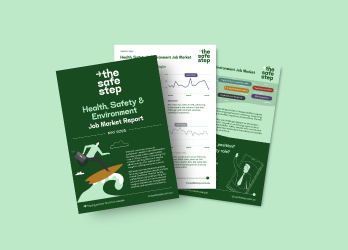Progress from safety expert to business leader
Page Published Date:
February 18, 2025
You've mastered the technical aspects of workplace health and safety. You're respected for your expertise and track record of success. But leadership demands a different skillset - one that's more about influence than technical excellence. Are you ready to develop the capabilities that will set you apart as a future safety leader

The leadership opportunity gap
The skills that made you successful in your current role won't necessarily get you to the next level. Technical expertise and compliance knowledge - while essential - aren't enough for senior leadership positions. The good news? Leadership capabilities can be learned. By developing these skills now, you'll be well-positioned to step up when opportunities arise.
As the current generation of safety leaders approaches retirement, new opportunities are emerging. But businesses aren't just looking to fill these positions - they're seeking a new style of safety leadership.
At a recent panel discussion, hosted by The Safe Step, industry leaders shared insights about the evolving nature of safety leadership. While technical expertise remains essential, organisations increasingly need safety leaders who can drive cultural change, influence strategy and translate safety imperatives into business outcomes.
Mastering the commercial conversation
"What differentiates leaders is their ability to have business conversations and ask commercially-focused questions," explains Katie Johnson, Director at The Safe Step. Technical expertise alone won't secure you a seat at the leadership table.
Start developing your commercial acumen by understanding your organisation's business model, revenue drivers and strategic challenges. When presenting safety initiatives, frame them in terms of business value and strategic outcomes rather than just risk mitigation.
Delivering builds influence
When stepping into broader roles, credibility comes from consistently delivering results. Josh Keech, Head of Employment Relations & Safety at ABC, emphasises the power of being known as someone who makes things happen: "When you tell a stakeholder 'I don't know exactly how yet, but we'll achieve that outcome' - and then you do - people start coming to you earlier with their challenges earlier so you can help form a solution with them."
This reputation for delivery creates opportunities to influence beyond traditional safety boundaries. You'll find yourself being invited into strategic discussions and asked to collaborate on business-wide initiatives.
Finding your authentic voice
Authenticity builds trust and creates lasting influence. Being genuine in your approach helps others connect with your message and understand your commitment to safety outcomes. Show vulnerability when appropriate - it's a strength that helps build deeper connections with your team and peers.
The secret is staying true to your values while adapting your communication style to different audiences. Rather than focusing solely on rules and compliance, connect through shared values around protecting people and enabling business success.
Understanding stakeholder needs
"Technical aspects and knowing the standards only get you so far," reflected Ben Kirkbride, Head of Health, Safety & Quality at Gamuda. The path to leadership requires looking beyond compliance and connecting with the broader business context.
The key is understanding what drives your stakeholders. Ben's mantra? "Whatever interests your manager should fascinate you." In other words, start paying more attention to the business challenges your leaders care about. This helps you frame safety initiatives in ways that resonate with decision-makers.
Partnering across functions
The lines between safety and HR are increasingly blurred, particularly in areas like psychosocial risk and respect at work. Josh's combined role as Head of Employment Relations & Safety at ABC exemplifies how these functions are converging. "When we're talking about these issues, senior leadership expects a united voice," he explains.
Building strong relationships with HR colleagues and understanding people-related challenges positions you as a more rounded leader. It also helps you navigate complex issues that span both functions more effectively.
Embrace opportunity
"Be open to trying something different and pushing yourself outside your comfort zone," advises Katie. "You never know where new experiences might lead." Ben agrees that the greatest growth often comes during challenging times - when you're feeling comfortable, you're not growing.
Angela Ewers, Chief People Officer at ARN Media, echoes this sentiment: "Just jump in and take opportunities when they're thrown your way. Even if you don't think you can do it, have a go - what's the worst that could happen?"
Preparing for future challenges
From AI and robotics to ESG imperatives, the safety profession is evolving rapidly. Stay informed through industry publications, podcasts and networking events. Consider studying a safety leadership course or attending HR conferences to broaden your perspective.
Leaders who understand emerging trends can help their organisations navigate change while maintaining focus on core safety outcomes. Be curious about developments in technology, sustainability and workplace culture - they'll increasingly shape how we approach safety management.
Building your support network
Leadership growth thrives on strong professional relationships. Build connections with peers who challenge your thinking and mentors who've walked your path. Remember that mentoring is a two-way street - the more you contribute to others' growth, the more you'll receive in return.
A specialist safety recruiter can help you understand emerging leadership trends, identify gaps in your leadership toolkit and connect you with opportunities that align with your career aspirations. They're also an excellent sounding board as you develop your "leadership voice" and professional brand.
Ready to broadcast your potential?
The journey to influential leader starts with expanding your perspective beyond technical excellence. Focus on understanding business priorities, developing commercial acumen and building meaningful relationships. Your unique voice as a safety leader is waiting to be heard.




